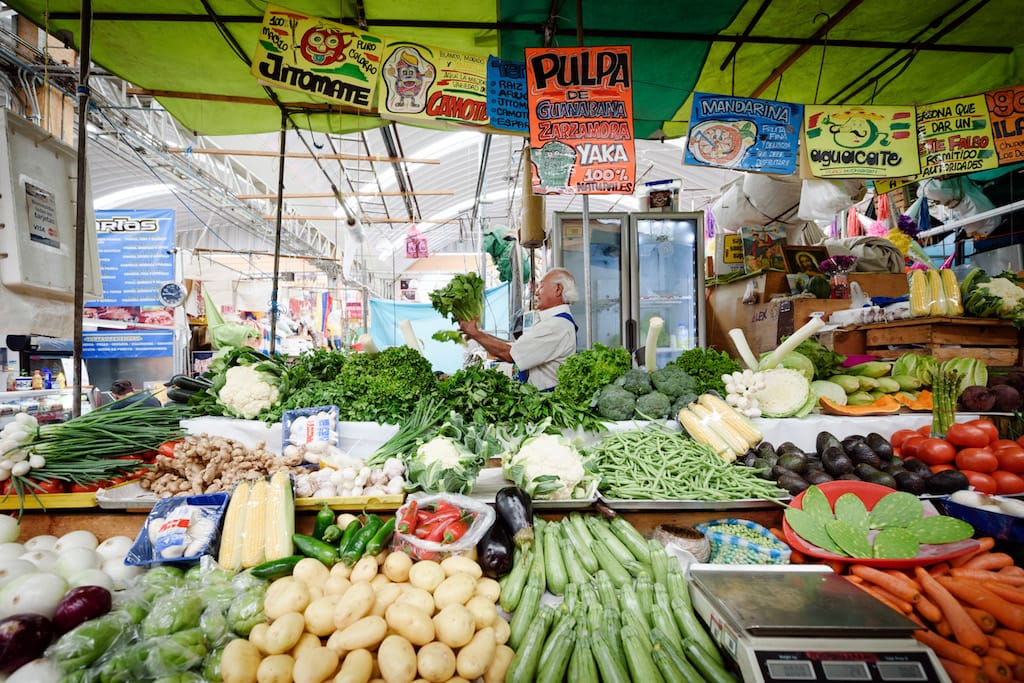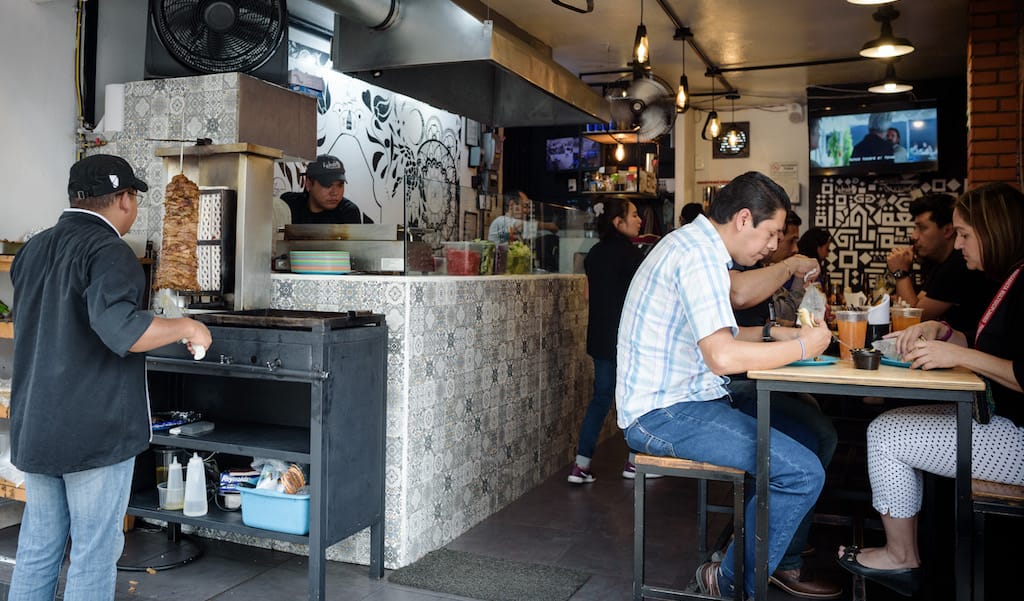“What year did you marry your wife?” we ask Rafael Hernandez, known as El Negrito of Mercado Medellín, one Saturday afternoon at his vegetable stand.
“I don’t know!” He breaks into uncontrollable laughter, “She knows though!”
“What year did we get married, Gorda?” he asks the woman next to him. Her hair is tightly permed and her hands are ever-busy sorting vegetables and tallying accounts
“I was 21 and you were 25, Negro – so more than 50 years,” Josefina says.
Rafael, now 79, with a shock of white hair and an easy smile, happily bustles around his stand. He and Josefina, 75, are two of the longest-standing vendors in the Roma neighborhood’s Mercado Medellín. The only other people who can remember the “old market” – how they refer to the first market building that was constructed in the 1930s – are over 90.

Rafa’s grandmother, Pascuala, came from Toluca in nearby Estado de Mexico and used to sell her wares at the tianguis (open-air market) down the street, almost from the time Colonia Roma was built. As Rafa describes it, the tianguis was a blanket of tarps on the ground where vendors sold produce and prepared food. The corner of Chiapas and Medellín Streets quickly became overwhelmed with vendors on market days and so they constructed the market building to try and control its expansion. By that time, his mother, Modesta, had taken over his abuela’s stand and was one of the first people to get an assigned spot in the new Mercado Melchor Ocampo, which locals took to calling Mercado Medellín because of the street it sits on. “Everything my mother made was exquisite,” Rafa says, “Sopes, gorditas, quesadillas, pancitas … the romeritos traditional to Christmas. She made all her tortillas by hand, she made everything fresh. Jews, Arabs, all of them came to eat at her stand. Everyone came.”
In fact, the Jewish community, mostly Syrian Jews from Aleppo and Damascus, comes up in almost any conversation about the market’s history. This community was an important part of the first 60 years of Colonia Roma’s life, and Jewish Mexicans handled the market administration until as recently as the ’80s. They were the first wave of immigrants to this part of the city, but over the years they’ve been replaced – most recently by young, English-speaking foreigners drawn to the neighborhood’s great food scene, walkable streets and “cool” atmosphere. “Nowadays, all our customers are young, and lots are foreigners,” says Josefina. “People come and go, and maybe they disappear for a while, then find their way back.”
Rafa spends most days on an elevated platform in the center of his vegetable pyramid admiring his wares. Rows of roma tomatoes, zucchinis, Serrano chiles, potatoes and green beans form the rainbow of produce that they sell.
The mix of clientele is part of the market’s charm. Walking through, you hear the singsong of Mexico City Spanish; English tongues sharpening soft Spanish vowels; tropical, round-tipped Cuban; rapid-fire Colombian; and, every once in a while, a loud voice in English leading a group of tourists among the aisles. In the 1980s, immigrants from Colombia, Venezuela and Cuba began requesting products from their homelands. Vendors took up the challenge, and now the market is known for its South and Central American wares.
Rafa’s son runs one such stand selling South American products in addition to the family’s fruit stand and several vegetable stands. They expanded bit by bit over the years, buying up other spots as they became available.
Rafa spends most days on an elevated platform in the center of his vegetable pyramid admiring his wares. Rows of roma tomatoes, zucchinis, Serrano chiles, potatoes and green beans form the rainbow of produce that they sell. Kitty corner, their fruit stand overflows with giant jackfruit, mangos, and mamey, and apples imported from the United States. On a good day you can find something exotic you’ve never even seen before like Brazilian guavas or zapotes borrachos, and Rafa always has a little extra, an artichoke flower maybe, for his most loyal customers.
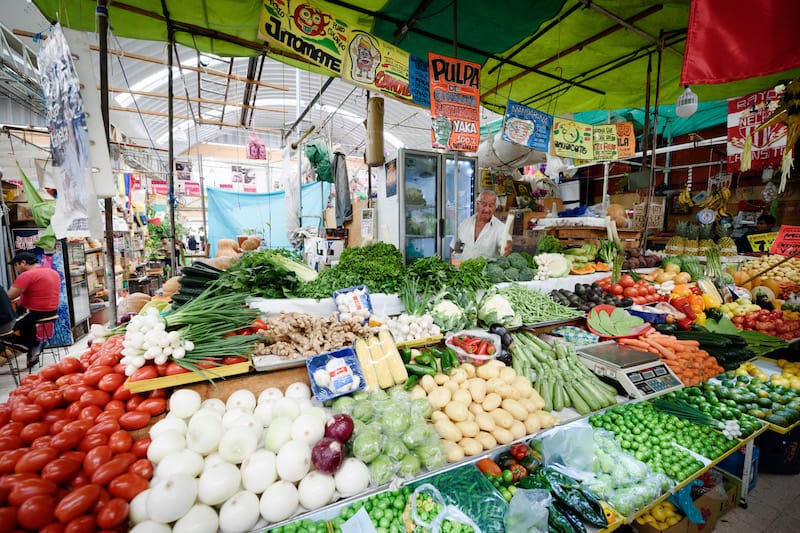
Modesta’s original food stand was sold years ago by Rafa’s sisters, and Josefina’s father’s stand is long gone, but the family remains a presence within the market, with three of Rafa’s children and several of his grandchildren working alongside their abuelos. “Our kids tell us we shouldn’t come anymore, should stay home,” Josefina says shaking her head. “What would we do at home? We need the work to keep us busy.”
Besides, they both agree, their house has become nothing more than a hotel for them. All day, every day, for almost their entire lives, they have come to the market. They eat here, socialize here and even spend their holidays here. Each day starts with a trip to the sprawling Central de Abastos market to buy produce for their stand, and ends as they sweep up stray lettuce leaves and chiles, carefully wrapping up produce for the following day. Some of Rafa’s earliest memories are of his mother sending him to the Merced to buy the day’s produce for her vegetable stand. “I was 7-years-old and she would send me at five in the morning to the Merced and Jamaica. She always made sure I was washed and properly dressed. Oh, maybe my pants were ripped here or there, but I was always clean… I like to think I’m still pretty clean,” he laughs.
Rafa and Josefina met and fell in love in the market. It’s been their children’s playground, and has been a part of all of their big moments – just as they have been present for all of the market’s big moments. When the 1956 market building was inaugurated, then-President Lopez Mateos himself came to the event. “He passed right by me, looking very elegant, and I stared right at him and he turned and shook my hand,” Rafa says, smiling at the memory. He and his family have also served as the main organizers of the market’s yearly anniversary on October 9th.
“Before, there was none of this,” Rafa gestures at the tarps, the divided stands and the electrical wires drooping down here and there. “The market was completely clean, there were no tubes, or anything – only stands. And the orchestras would play, one on this side of the market and one on the other, and they could see each other across the room.” We tell him it sounds like it was beautiful. He nods.
All the wear and tear aside, when we ask him why he thinks the Mercado Medellín has still managed to flourish when so many other neighborhood markets have not, he says it’s because there is a generation of people in the Roma that simply won’t let it go, who will always come to the market’s rescue if needed.
“You know,” he says suddenly, “the Mercado Medellín is the most beautiful market in the world. Do you know why?”
“Why?”
“Because it fed my family with this work.” At that, he resumes sorting his cilantro, prepping for another day, and the customers that will come with it.
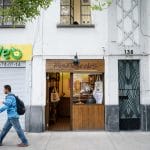 September 16, 2021 Mis Mezcales
September 16, 2021 Mis Mezcales
Has mezcal gone the way of avocado toast, an item that’s become shorthand for cliched […] Posted in Mexico City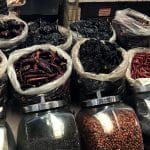 June 14, 2019 Building Blocks
June 14, 2019 Building Blocks
If Mexico had to choose a national flavor, the chile pepper would without a doubt be the […] Posted in Mexico City April 22, 2021 Kebab Nation
April 22, 2021 Kebab Nation
At Culinary Backstreets, we tend to opt for tradition over trendy, street over chic. We […] Posted in Mexico City
Published on June 18, 2019
Related stories
September 16, 2021
Mexico CityHas mezcal gone the way of avocado toast, an item that’s become shorthand for cliched hipster trendiness? If you think yes, a visit to Mis Mezcales in Mexico City’s Colonia Roma may be in order. There, you will find Omar Trejo sitting behind his unassuming makeshift bar, parceling out sips to the uninitiated and reminding…
June 14, 2019
Mexico CityIf Mexico had to choose a national flavor, the chile pepper would without a doubt be the winner. The only issue might be which chile would take the top spot in such an honor. The country is home to more than 200 variations of chiles, stemming from some 64 distinct varieties. Almost no meal is…
April 22, 2021
Mexico CityAt Culinary Backstreets, we tend to opt for tradition over trendy, street over chic. We delve into a city’s blind spots when it comes to local favorites. Taking that approach makes it too easy to dismiss new spots out of hand. So, if it weren’t for our friend Liz hounding us for months about a…







































